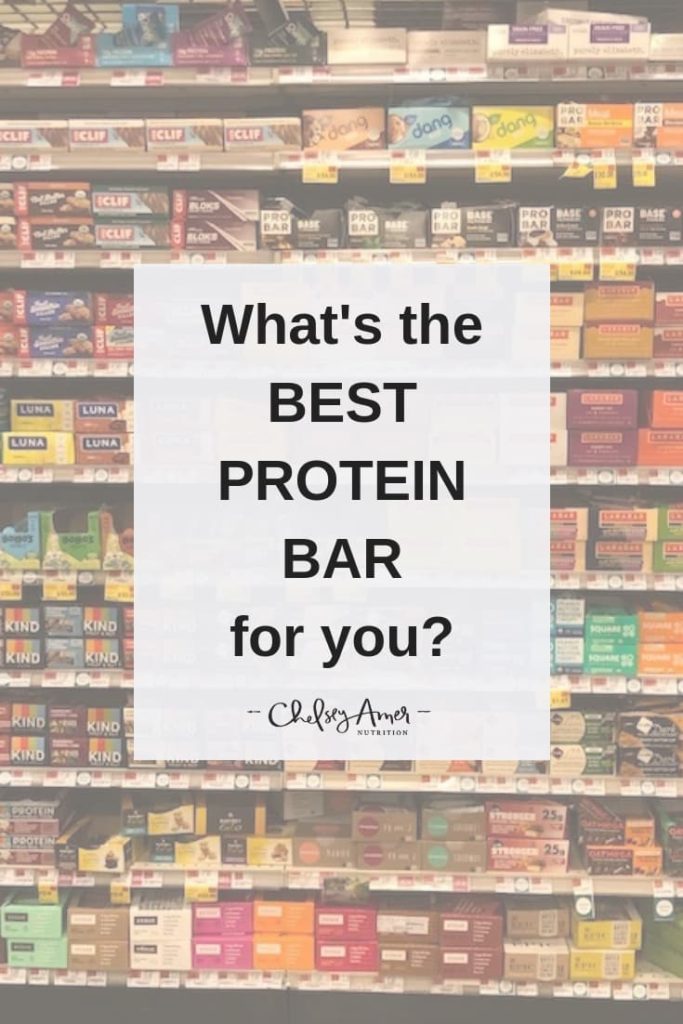What’s the Best Protein Bar?
One of the most common questions I receive from clients, friends, and my online community is “What’s the best protein bar?”
Today I’m revealing my dietitian-approved criteria about what you should look for in a protein bar, what options are more like a glorified candy bar, and the role protein bars should play in your overall diet. Plus, get my FREE “Protein Bar Comparison Cheat Sheet” to help guide your choices!
Let’s dive in…

In my years of private practice, one common question comes up time and time again, no matter what the reason for working together…
The best PROTEIN BARS!
Are they OK to eat? Which ones do I recommend? How can they tell if it’s a good option?
The questions are endless because there’s SO MUCH CONFUSION about protein bars!
To be honest, MOST protein bars on the market are glorified candy bars or are packed with junk (and by junk I mean artificial ingredients). It’s important to become a label reading sleuth to determine if a bar is your best bet.
Plus, for those of us with food allergies, there’s an extra challenge. Many of the best options are packed with common allergens (especially nuts, eggs, wheat). Even if the bar itself doesn’t contain a common allergen, many are “made in a facility that uses nuts,” increasing the risk of cross-contamination. I included some of my favorite allergy-friendly bars in my suggestions, but keep in mind that many of these bars don’t 100% meet my desired dietitian-approved criteria.
Are protein bars OK to eat?
My quick response is “of course!” HOWEVER, I think a lot of individuals use protein bars as a crutch. Perhaps you can relate… You don’t want to spend time making (portable) snacks or thinking of another snack, so you rely on throwing a bar in your bag.
Or you’re not quite hungry enough for breakfast, so you grab a bar.
There’s a few reasons I’m NOT a fan of protein bars or energy bars…
1. They’re dense. Most bars pack a decent amount of calories (AKA energy) into a tiny surface area. Oftentimes I find the lack of volume doesn’t fill you up and shut off your hunger completely (especially if you struggle with identifying your hunger and fullness cues).
2. They have a lot of sugar. Whether the sugar in protein/energy bars is added sugar (brown rice syrup, honey, agave, maple syrup, cane sugar, etc.) or natural sugar (sugar from dried fruit, most of the time), it’s still sugar. If you’re using your protein bar as a make-shift breakfast, this may be more sugar than you want to indulge in first thing in the morning.
Additionally, the sugar may not be balanced by enough protein to truly help you balance your blood sugar (and yes, snacks should be balanced too!). This may lead to a blood sugar crash, which won’t help your metabolism.
3. They have artificial ingredients. If you were creating a protein bar in your kitchen, would you use “soy lecithin” or “erythritol?” For most people, the answer is a big fat NO!
Will these ingredients harm your health every once in a while? Likely not! But I like bars to include ingredients you recognize, because that’s what I think a snack should be! This includes skipping those bars that contain artificial sweeteners (see below for more on this).
For most people, protein bars should not make an everyday appearance.
I recommend bars FOR EMERGENCIES ONLY! Keep a dietitian-approved protein bar on the bottom of your bag, in your glove compartment, or in your locker for when hanger strikes and you need something ASAP!
Not for everyday breakfast out the door… (Spend an extra 5 minutes to prep chia pudding or make egg muffins over the weekend.)
Not for daily snack at your desk… (That’s what veggies + hummus or an apple and nut/seed butter are for!)
Not for your evening munchies… (Try some fruit, popcorn, real chocolate, or even ice cream instead!)
At least that’s my professional opinion. I want you to choose more whole foods that take time to chew. AKA foods that take up VOLUME in your stomach. Food that contains more antioxidants, vitamins, and minerals than what’s typically found in a protein bar.
Important note: You WILL notice some of these artificial ingredients (like soy lecithin) in the bars I recommend. That’s why I suggest limiting bars to a once in a while, emergency “rescue my hanger” type of food. And remember, there’s no such thing as a perfect diet!
What should you look for in a protein bar?
There are a few important criteria to look for when choosing a protein bar. The “green” suggestions in my FREE Protein Bar Comparison Cheat Sheet meet MOST of these suggestions (or get pretty darn close!).
Here are some guidelines to help you choose the best protein bar…
1. Look for INGREDIENTS you can recognize
When reading a Nutrition Facts label, I always suggest you read the ingredients label FIRST. Forget the calories, protein, etc. Look at the INGREDIENTS.
This is your first clue as to whether or not the bar in your hands is made from REAL FOOD. If you can’t recognize [synthetic] ingredients included, SKIP IT!
Do you recognize a source of protein? Are there several types of added sugars? These are your initial clues as to whether or not this protein bar is a good choice.
2. Check the grams of PROTEIN
Since it’s a PROTEIN bar (not a candy bar, not a fiber bar, not a fat bar…), look on the Nutrition Facts panel for the grams of protein.
I typically suggest that a snack has about 10 grams of protein.
And this is hard to find! However, if you’re using your bar as a snack, 10 grams is a decent amount of protein to help boost satiety. If it’s breakfast, I suggest bumping up your protein even more and perhaps pairing your bar with a Greek yogurt or cottage cheese.
Some sources of protein that you may recognize on ingredient labels include:
- Nuts and seeds (also fats!)
- Collagen protein powder
- Egg whites (dehydrated)
- Brown rice powder
- Milk powder (dehydrated milk)
- Pea protein
- Whey protein
- Hemp protein
- And more
3. Look for FIBER
Remember, fiber will help you feel full. Fiber swells in your intestines, so even though your protein bar is compact, if it contains a decent amount of fiber, it will keep you full for much longer than if it’s a low fiber, protein-heavy bar.
I prefer bars to contain AT LEAST 5 grams of fiber!
Some ingredients that indicate you’ll find fiber in your bar are…
- Chia seeds
- Flaxseeds
- Chicory root fiber
- “Prebiotic fiber blends”
- Dried fruits
- Acacia fiber
- Oat fiber
- And more
Keep in mind that some of these types of fiber may cause stomach upset or distress. If you have any GI issues, check with your dietitian, or be wary if you notice stomach upset after eating a high fiber bar.
4. Be mindful of the SUGAR content
Many protein bars are actually glorified candy bars. This is why it’s SO important to check the package for sugar – both natural sugars and added sugars.
For bars, you’ll find natural sugars usually come from fruit. Dates, dried cranberries, prunes, etc., all contribute NATURAL sugar.
Added sugars come from forms of sugar that’s ADDED. This can include less processed forms of sugar, like honey, agave, and maple syrup, or more processed forms of sugar like straight up cane sugar.
When reading the Nutrition Facts label, remember that 4 grams of sugar equals 1 teaspoon of sugar. Think of it this way: for every 4 grams of added sugar listed, imagine sprinkling a teaspoon of granulated sugar on your snack. Not exactly ideal, since too much added sugar can lead to unwanted lbs, inflammation, and more.
Of course, we prefer natural sugars over added sugar, but we still want to make sure the natural sugar in your bar BALANCES out the other nutrients (namely protein and fat).
5. Watch out for artificial sweeteners
The last component I want you to check is for artificial sweeteners, including more “natural” sweeteners like stevia. Artificial sweeteners can trick your taste buds into craving more sweets (which we want to avoid).
Some common artificial sweeteners listed in bars include:
- Stevia
- Erythritol
- Monk fruit extract
- And more

Dietitian-Approved Protein Bars
I created a downloadable PDF (below) for you to use as a bar comparison. I included every bar that my online community mentioned, as well as some that I recommend to clients.
Before you check it out, remember that NO 1 BAR IS PERFECT!!!! (That’s why bars aren’t my first round draft pick!)
I used 3 classifications for bars: Green, Yellow, and Red. Here’s what they mean:
Green: The best options are highlighted in green. They meet my minimum fiber and protein recommendations, contain MOSTLY whole food ingredients, and do not contain artificial sweeteners.
Yellow: The next best options are highlighted in yellow. You’ll notice that most bars are designated as yellow because they meet or come pretty close to the minimum fiber and protein recommendations, and perhaps contain a few more “not my favorite” ingredients, like artificial sweeteners.
If you’ve experimented with your tolerance to artificial sweeteners, and you’re not impacted as much, then some of these options may be great for you if they meet the minimum recommended fiber and protein content.
Red: My least favorite options are highlighted in (pale) red. They do not meet my minimum fiber and protein recommendations and contain fewer whole food ingredients. So, I suggest using these when out in a crutch only. HOWEVER, all foods can fit in a well-balanced diet. I just don’t want you thinking that these are “protein bars” when they have more sugar and unnecessary ingredients that make them closer to a candy bar or artificially-created food. It’s all about knowing your goals and target foods that will help you feel your best!
Some other notes to keep in mind when referencing this spreadsheet:
- The ingredients and Nutrition Facts listed are for the random flavor that I chose to evaluate. Please note, that each brand has multiple flavors, which will change these stats slightly. This is just to be used as a starting point!
- I listed some basic pros and cons worth pointing out for each bar. This is by no means a comprehensive list.
- Taste is so individualized, so I did not reference the taste and texture of the bars. I chose these 25+ bars to include based on your recommendations.
- Most important, keep in mind what works for you, may not be what works for someone else. These are GENERAL GUIDELINES!
Download your Best Protein Bar Comparison Cheat Sheet here!

Do you have a favorite bar that’s not included in my dietitian-approved comparison cheat sheet? Let me know and I’ll be happy to add to it!
Questions? Concerns?
I’d love to hear from you!
XO


 Hi there!
Thanks for stopping by! I'm Chelsey, an online Registered Dietitian, recipe developer, budding photographer, and coffee addict! My mission is to help you feel good through food by answering the question "What should I eat?" Let's make nutrition approachable!
I hope you enjoy my personal collection of simple, healthy, food allergy friendly and nutritiously delicious recipes, plus tips and tons of tricks that will help YOU live a nutritionally-balanced life! I look forward to getting to know you better...
Hi there!
Thanks for stopping by! I'm Chelsey, an online Registered Dietitian, recipe developer, budding photographer, and coffee addict! My mission is to help you feel good through food by answering the question "What should I eat?" Let's make nutrition approachable!
I hope you enjoy my personal collection of simple, healthy, food allergy friendly and nutritiously delicious recipes, plus tips and tons of tricks that will help YOU live a nutritionally-balanced life! I look forward to getting to know you better...







